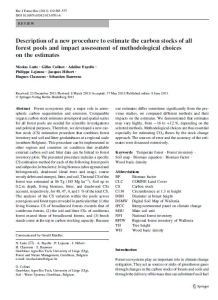Latte N., Colinet G., Fayolle A., Lejeune P., Hébert J., Claessens.H., Bauwens. S. [2013] Description of a new procedure to estimate the carbon stocks of all forest pools and impact assessment of methodological choices on the estimates. European Journal of Forest Research 132(4), 565-577
Forest ecosystems play a major role in atmospheric carbon sequestration and emission. Comparable organic carbon stock estimates at temporal and spatial scales for all forest pools are needed for scientific investigations and political purposes. Therefore, we developed a new carbon stock (CS) estimation procedure that combines forest inventory and soil and litter geodatabases at a regional scale (southern Belgium). This procedure can be implemented in other regions and countries on condition that available external carbon soil and litter data can be linked to forest inventory plots. The presented procedure includes a specific CS estimation method for each of the following forest pools and subpools (in brackets): living biomass (aboveground and belowground), deadwood (dead trees and snags, coarse woody debris and stumps), litter, and soil. The total CS of the forest was estimated at 86 Tg (185 Mg ha−1). Soil up to 0.2 m depth, living biomass, litter, and deadwood CSs account, respectively, for 48, 47, 4, and 1 % of the total CS. The analysis of the CS variation within the pools across ecoregions and forest types revealed in particular that: (1) the living biomass CS of broadleaved forests exceeds that of coniferous forests, (2) the soil and litter CSs of coniferous forest exceed those of broadleaved forests, and (3) beech stands come at the top in carbon stocking capacity. Because our estimates differ sometimes significantly from the previous studies, we compared different methods and their impacts on the estimates. We demonstrated that estimates may vary highly, from −16 to +12 %, depending on the selected methods. Methodological choices are thus essential especially for estimating CO2 fluxes by the stock change approach. The sources of error and the accuracy of the estimates were discussed extensively.
Consultez la notice complète de l’article sur ORBi

